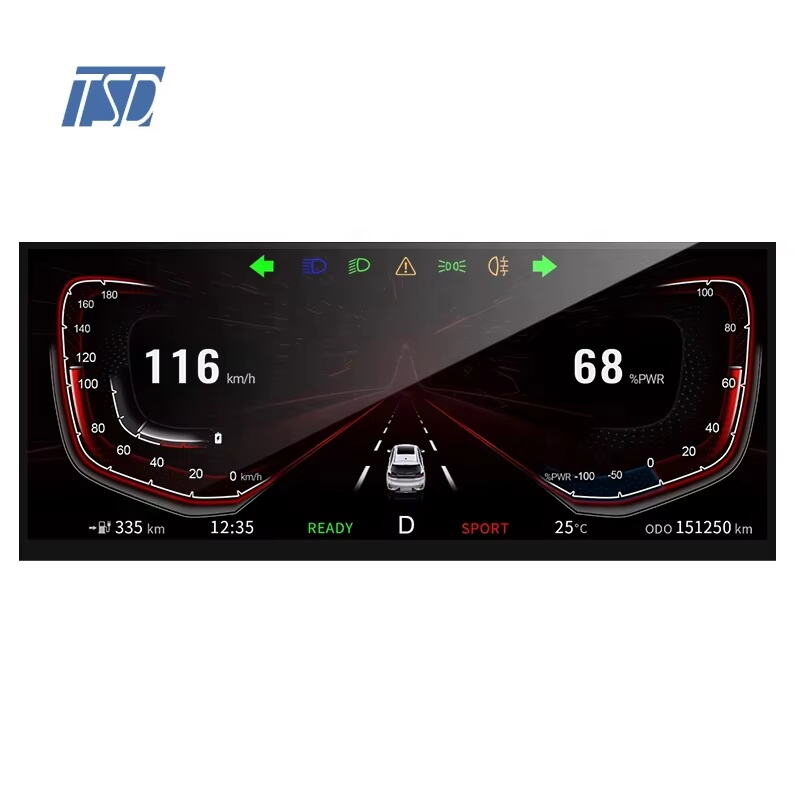Introduction: The Growing Importance of Automotive LCD Display Modules
Defining the Role of LCD Modules in Modern Vehicles
Automotive LCD display modules are central to the modern vehicle's ecosystem, acting as key interfaces for controls, infotainment, and navigation. These displays serve as hubs where drivers can manage vehicle settings, engage with multimedia content, and access real-time navigational information. The integration of such modules into vehicle dashboards significantly enhances both the aesthetics and functionality by replacing traditional dials with sophisticated digital displays, resulting in a more streamlined and modern appearance. According to recent industry statistics, a majority of new vehicles, upwards of 80%, now incorporate some form of LCD technology, highlighting its dominance and utility in enhancing the driving experience.
Market Growth Projections for In-Vehicle Infotainment Systems
Market research forecasts suggest that the in-vehicle infotainment systems market is set to experience significant growth over the next five years. This growth is fueled by increasing consumer demand for high-performance LCD displays that offer enhanced visual experiences. For example, reports from the Future Market Insights indicate that the automotive display units market is expected to grow from USD 42.15 billion in 2025 to USD 74.78 billion by 2035, representing a compound annual growth rate (CAGR) of 5.9%. As consumer preferences lean more towards advanced LCD technology, automotive manufacturers and suppliers are investing heavily in these new technologies, integrating features like augmented reality (AR) and head-up displays (HUDs) to meet expectations and capitalize on this lucrative market trend.
Enhanced Driver Experience Through Advanced Integration
Navigation System Integration and Real-Time Updates
Integrated navigation systems significantly enhance driver satisfaction and safety by providing precise route guidance and traffic updates. The inclusion of real-time data, such as that offered by services like Google Maps, ensures that drivers receive timely information regarding road conditions, alterations in traffic patterns, and directions, thus boosting the overall driving experience. According to a report by Navigant Research (Guidehouse), nearly 90% of drivers rely heavily on GPS and navigation features in their vehicles, underscoring the importance of integrating navigation systems for modern vehicles.
Seamless Multimedia Streaming & Connectivity Solutions
Automotive LCD displays offer compatibility with multimedia streaming services, ensuring quality entertainment and information access for drivers and passengers alike. Connectivity solutions such as Apple CarPlay and Android Auto have transformed user engagement by allowing for seamless access to applications and content directly from the vehicle's interface. Consumers increasingly prefer vehicles with robust multimedia capabilities, which now represent a key factor influencing vehicle choice, as highlighted by insights from Voicebot.ai, which indicate growing demand for integrated streaming services across vehicle infotainment systems.
Vehicle-to-Everything (V2X) Communication Capabilities
Vehicle-to-Everything (V2X) communication is crucial for improving safety and traffic efficiency in modern transportation systems. Using automotive LCD display technology, crucial V2X data can be visualized for drivers, allowing them to better comprehend their surroundings and react appropriately to traffic conditions. Studies indicate that V2X systems have a measurable impact on reducing traffic accidents, due to enhanced communication between vehicles and infrastructure. This information flow, visualized through automotive displays, represents an advance in ensuring that drivers are both informed and safer on the roads.
Advanced Features Revolutionizing User Interaction
High-Responsiveness Touchscreen Interfaces
High-responsiveness touchscreen interfaces in vehicles are transforming user interaction by making control more intuitive and seamless. Technological advancements have significantly reduced lag, offering a more fluid touch experience. According to recent surveys, consumer satisfaction has markedly improved in cars equipped with these sophisticated displays, often citing the ease of navigation and control. Manufacturers are investing in both software and hardware enhancements to fine-tune these interfaces, improving interaction quality and response time. This includes the adoption of cutting-edge processors and sensitive touch sensors to provide an effortless user experience.
AI-Powered Voice Control Systems
AI-powered voice control systems are redefining how drivers interact with their vehicles, allowing for safer, hands-free operation. These systems leverage advanced AI algorithms to understand and execute voice commands accurately, minimizing distraction and enhancing safety on the road. Studies have shown a positive correlation between the use of voice control and a decrease in driver inattention incidents. Features such as adjusting temperature settings, navigating through GPS, and operating music systems have become standard, showcasing the shift towards a more interactive driving experience. As AI technologies continue to evolve, voice control systems will likely become even more sophisticated and reliable.
Gesture Recognition and Haptic Feedback Technologies
Gesture recognition technology offers a hands-free way of interfacing with vehicle systems, allowing drivers to focus on the road while accessing essential functions. This technology enables users to control infotainment features through simple hand movements, ensuring a safer driving environment. Meanwhile, haptic feedback technologies complement gesture recognition by providing tactile responses, confirming that a command has been received or executed. Data suggest users feel more confident and comfortable using systems that combine gestures and haptic feedback, as they offer a satisfying and effective way to interact with the car's features. Such advancements in user interface design are crucial as the industry moves towards more immersive and integrated automotive environments.
Superior Display Quality for Optimal Performance
4K Resolution and HDR Compatibility
In recent years, the advent of 4K resolution displays has significantly heightened the visual experience in luxury vehicles. By offering higher pixel density, these displays provide unprecedented clarity and detail, making navigation maps, videos, and other visual content more engaging for users. HDR (High Dynamic Range) compatibility enhances this experience by ensuring richer colors and better contrast, regardless of the lighting conditions. According to a recent market study, there is growing consumer preference for high-resolution displays, particularly among those purchasing premium vehicles. This trend suggests an increased demand for automotive LCD display modules that can deliver exceptional visual performance.
Wide Viewing Angles & Anti-Glare Surface Treatments
Wide viewing angles are essential for enhancing passenger experience and ensuring critical information is easily visible, irrespective of the seat location or time of day. These angles allow all passengers to have a clear and unobstructed view of the screen, contributing to a safer and more enjoyable ride. Furthermore, anti-glare surface treatments have become a focal point in display technology advancements. These treatments minimize reflections and enhance visibility even in bright sunlight, addressing common complaints about screen glare. Consumer feedback has indicated a strong preference for displays with effective anti-glare properties, demonstrating their importance in automotive screen design.
Adaptive Brightness for Day/Night Driving Conditions
The inclusion of adaptive brightness technology is transforming the usability of automotive displays. This technology adjusts screen brightness based on ambient lighting conditions, ensuring optimal visibility and comfort for drivers. It utilizes sensors that detect changes in external light, automatically dimming or brightening the display as needed. Such adaptive controls reduce distractions and improve driver safety by maintaining the readability of essential information both during the day and at night. Statistics indicate that improper brightness settings can lead to driver distractions, highlighting the importance of adaptive solutions for contemporary vehicle displays.
Emerging Trends in Automotive Display Technology
Curved LCD Displays for Ergonomic Dashboards
Curved LCD displays are revolutionizing vehicle design by offering both aesthetic appeal and functional benefits. These displays enhance the ergonomics of the dashboard, creating a seamless integration that aligns with the natural curvature of the cockpit. This design promotes a more intuitive line of sight for drivers, reducing unnecessary head movements and resulting in a safer and more comfortable driving experience. Design trend data indicates a growing preference for these displays, as they offer modern elegance combined with practical functionality. As consumer interest in visually appealing yet functional automotive interiors grows, curved LCD technology is expected to become a staple in innovative car designs.
Multi-Screen Configurations and Digital Cockpits
The adoption of multi-screen configurations is significantly transforming driver experiences and setting the foundation for digital cockpits in modern vehicles. Multiple screens allow drivers and passengers to interact with diverse interfaces simultaneously, enhancing navigational guidance, entertainment features, and real-time data monitoring. Digital cockpits redefine the concept of vehicle dashboards by integrating infotainment systems, driver assistance technologies, and vehicle diagnostics into a unified platform. Statistics suggest an increasing trend towards these configurations, driven by the desire for enhanced vehicle functionality and personalized user experiences. As digital ecosystems within vehicles evolve, these technologies will become standard, reflecting the growing demand for interconnected automotive solutions.
FAQ
What are automotive LCD display modules?
Automotive LCD display modules are digital screens used in vehicles for controls, infotainment, and navigation purposes. They enhance the aesthetics and functionality of a vehicle's dashboard.
How do LCD modules benefit modern vehicles?
LCD modules in modern vehicles serve as central interfaces, allowing drivers to manage vehicle settings, multimedia content, and navigation information effortlessly, thus enhancing the driving experience.
Why is there a growing interest in high-resolution automotive displays?
High-resolution displays, such as 4K resolution and HDR compatibility, provide enhanced visual clarity and color richness, significantly improving the visual experience for drivers and passengers.
How does adaptive brightness technology work?
Adaptive brightness technology adjusts the display's brightness based on ambient light conditions, optimizing visibility for drivers during both day and night driving scenarios.
What are OLED and hybrid display solutions?
OLED displays offer superior color accuracy and energy efficiency but are costly. Hybrid solutions merge the strengths of OLED and LCD technologies, providing a balance between performance and cost-effectiveness.




